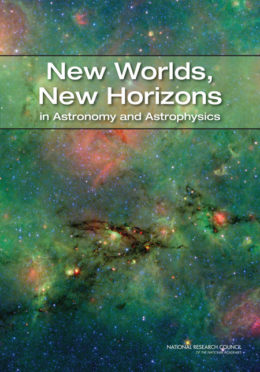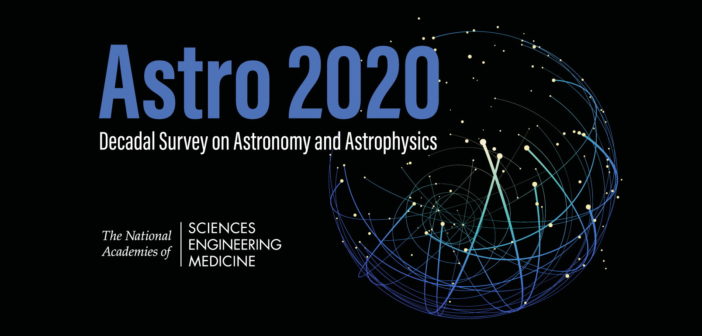What are the big topics in astronomy research that we’ll be working to address in the next decade? No need to pull out a crystal ball … astronomers have a pretty good guess, and they’ve shared what they think in a series of white papers that are part of the 2020 Decadal Survey.
What’s a Decadal Survey?

Have we achieved our goals from the previous Decadal Survey, Astro2010? You’ll have to check out the Astro2010 report and decide for yourself. [National Academies]
How Does It Work?
Astro2020 begins with various calls for “white papers”, brief write-ups to be submitted by individuals or collaborations within the astronomy community. These white papers are next reviewed by a steering committee made up of prominent members of the astronomy community. Finally, the committee — with input from topical panels, subcommittees, town halls, and more — composes a report that describes the current state of the field, identifies research priorities, and makes recommendations for the next decade.
What’s Happening Now?
The first Astro2020 white-paper call closed in March. The assignment:
“succinctly identify new science opportunities and compelling science themes, place those in the broader international scientific context, and describe the key advances in observation, experiment, and/or theory necessary to realize those scientific opportunities within the decade 2020-2030.”
The result? A collection of 573 white papers from the community that beautifully summarizes the most interesting research questions that are driving the field forward at this time. Want a glimpse of what’s interesting in astronomy right now? All you have to do is look through these papers to get a very good idea.

Astro2020 white papers will be published in the Bulletin of the American Astronomical Society. [AAS]
How About a Brief Sample?
Astronomy is an enormous field, and these white papers prove it. Below is a tiny sample of papers covering each of the eight primary thematic science areas (plus two bonus interdisciplinary ones).
- Planetary systems
• The Sun-like Stars Opportunity
• Solar System Science with Space Telescopes
• A Balancing Act: Biosignature and Anti-Biosignature Studies in the Next Decade and Beyond - Star and planet formation
• The Life Cycle of Dust
• Planet formation — The case for large efforts on the computational side
• Astrochemical Origins of Planetary Systems - Stars and stellar evolution
• Stellar Physics and Galactic Archaeology using Asteroseismology in the 2020’s
• Stars at High Spatial Resolution
• Radio, Millimeter, Submillimeter Observations of the Quiet Sun - Formation and evolution of compact objects
• Populations of Black holes in Binaries
• Radio Pulsar Populations
• Ultra-heavy cosmic-ray science: Are r-process nuclei in the cosmic rays produced in supernovae or binary neutron star mergers? - Resolved stellar populations and their environments
• Increasing the Discovery Space in Astrophysics: The Exploration Question for Resolved Stellar Populations
• Local Dwarf Galaxy Archaeology
• Far Reaching Science with Resolved Stellar Populations in the 2020s - Galaxy evolution
•The Magellanic Stream as a Probe of Astrophysics
• Simultaneous Measurements of Star Formation and Supermassive Black Hole Growth in Galaxies
• Observing Galaxy Evolution in the Context of Large-Scale Structure - Cosmology and fundamental physics
• The Role of Machine Learning in the Next Decade of Cosmology
• Tests of General Relativity and Fundamental Physics with Space-based Gravitational Wave Detectors
• Cosmology with the Highly Redshifted 21 cm Line - Multi-messenger astronomy and astrophysics
• A Summary of Multimessenger Science with Neutron Star Mergers
• Astrophysics Uniquely Enabled by Observations of High-Energy Cosmic Neutrinos
• Gravity and Light: Combining Gravitational Wave and Electromagnetic Observations in the 2020s
- Interdisciplinary
• Astrophysical Science enabled by Laboratory Astrophysics Studies in Atomic, Molecular, and Optical (AMO) Physics
• The Next Decade of Astroinformatics and Astrostatistics
What Comes Next?
We’re nowhere near done yet! The papers published now were submitted to the call for science white papers in March. At present, there’s another call open for white papers on activities, projects, and the state of the profession, with a deadline of 10 July.
All of these white papers will be included in the BAAS as well. Check back for those later this year, and keep an ear to the ground as the year progresses for more news from Astro2020.
Citation
The full set of Astro2020 science white papers can be found here:
https://baas.aas.org/community/astro2020-science-white-papers/

4 Comments
Pingback: Allgemeines Live-Blog ab dem 10. Juni 2019 | Skyweek Zwei Punkt Null
Pingback: AAS 234: Day 2
Pingback: Astrobites at AAS 237: Day 2 | astrobites
Pingback: AAS 237: Day 2